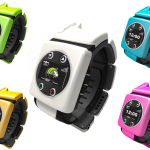The concept of a Child Locator GPS device first came to my attention in the aftermath of my daughter Polly’s 1993 tragedy. The main obstacle at that time was the same one that exists today: battery life.
Currently, there are 32-GPS satellites orbiting the earth. The satellites, operated by the US Department of Defense, orbit with a period of 12 hours (2-orbits/day) at a height of about 11,500 miles traveling at 9,000 mph. Each GPS satellite is constantly transmitting its precise location back to earth. GPS receivers take this locator information from individual GPS satellites and use triangulation to calculate the GPS receiver’s exact location. Triangulation is a way of determining something’s location using the locations of other things, in this case line of sight GPS satellites orbiting the earth. In order to facilitate current location updates any GPS device requires a constant power source.
There are plenty of Child Locator GPS devices on the market. One popular way to go is to simply purchase the Family Locator option from you cell phone provider (ATT, Sprint, Verizon, T-Mobile). For a very reasonable price you are able to track up to 10-GPS equipped cell phones. All cell phones in use are GPS equipped. Typically, child locator services allow you to pinpoint the device at pre-determined intervals (breadcrumbs), create inclusion zones that notify you if the device leaves a specific radius (geo-fencing), allow you to follow progress in a vehicle and notes how fast the vehicle is travelling, and has a panic button children can press if threatened.
Another popular option is to purchase a stand-alone Child Locator GPS device. Smaller than cell phones, but not as versatile, these devices can be placed in backpacks, in pockets, etc. Some of these devices have the added feature of providing location service for registered sex offenders in your immediate vicinity.
Like cell phone child locator services, stand-alone products require a monthly data plan to access services. In both instances the device battery must be recharged regularly: at least once per day. One can access, set and observe location services via online mapping programs.
The problem with this approach is that it is the device that is being tracked, not the child. The KlaasKids Foundation is currently involved in the case of a teenager, who disappeared in March, 2012. Her GPS enabled cell phone was located two days after she disappeared, but Sierra LaMar remains missing to this day.
The trick then, is to create a product with sufficient battery life to keep the device constantly running, that stays with the child at all times. Battery technology is not sufficiently advanced to make jewelry a viable option. Even larger items like belt buckles are problematic at this time. However, there is a company that will soon be producing a wristwatch with extended battery life, and titanium infused wristbands designed so that they can only be removed by a unique key fob that remains with the parents.
 The LEO Wristwatch, cell phone will provide all of the services outlined above, plus two way communication, a nearly impossible to remove wristband, and a 911 panic button. I have personally tested LEO’s functionality and am convinced that once it reaches the marketplace this device could be the game changer I envisioned while we were still looking for Polly.
The LEO Wristwatch, cell phone will provide all of the services outlined above, plus two way communication, a nearly impossible to remove wristband, and a 911 panic button. I have personally tested LEO’s functionality and am convinced that once it reaches the marketplace this device could be the game changer I envisioned while we were still looking for Polly.
Before I finish, I would like to address the elephant in the room. Many people are under the misconception that an implantable chip exists that will perform most of the functions previously discussed. Unfortunately, this is not the case. These well-meaning, but misguided folks argue that we have been utilizing this kind of technology to track pets and other wild life for decades now. In truth, a microchip implant is an identifying integrated circuit placed under the skin of a dog, cat or other animal. The chip, about the size of a grain of rice, uses passive RFID (Radio Frequency Identification) technology.
Technology is coming ever closer to the dream of a GPS device that will perform multiple functions, stay with the child and ultimately dissuade perverts from grabbing our kids. Until that day arrives, our best options are Cell Phone Locator Services and Stand Alone GPS Devices.






